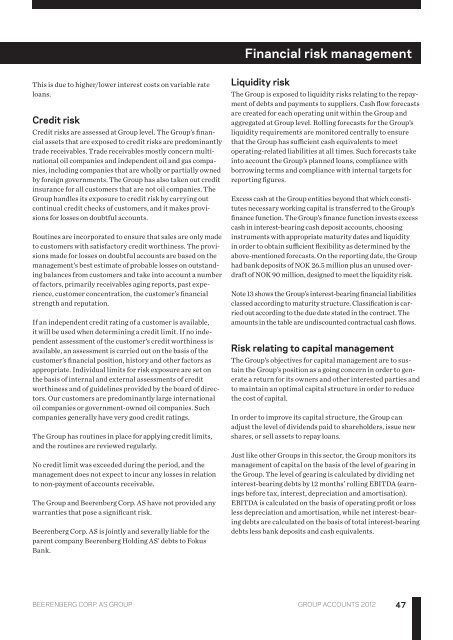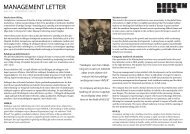Note 1 - Beerenberg
Note 1 - Beerenberg
Note 1 - Beerenberg
You also want an ePaper? Increase the reach of your titles
YUMPU automatically turns print PDFs into web optimized ePapers that Google loves.
Financial risk management<br />
This is due to higher/lower interest costs on variable rate<br />
loans.<br />
Credit risk<br />
Credit risks are assessed at Group level. The Group’s financial<br />
assets that are exposed to credit risks are predominantly<br />
trade receivables. Trade receivables mostly concern multinational<br />
oil companies and independent oil and gas companies,<br />
including companies that are wholly or partially owned<br />
by foreign governments. The Group has also taken out credit<br />
insurance for all customers that are not oil companies. The<br />
Group handles its exposure to credit risk by carrying out<br />
continual credit checks of customers, and it makes provisions<br />
for losses on doubtful accounts.<br />
Routines are incorporated to ensure that sales are only made<br />
to customers with satisfactory credit worthiness. The provisions<br />
made for losses on doubtful accounts are based on the<br />
management’s best estimate of probable losses on outstanding<br />
balances from customers and take into account a number<br />
of factors, primarily receivables aging reports, past experience,<br />
customer concentration, the customer’s financial<br />
strength and reputation.<br />
If an independent credit rating of a customer is available,<br />
it will be used when determining a credit limit. If no independent<br />
assessment of the customer’s credit worthiness is<br />
available, an assessment is carried out on the basis of the<br />
customer’s financial position, history and other factors as<br />
appropriate. Individual limits for risk exposure are set on<br />
the basis of internal and external assessments of credit<br />
worthiness and of guidelines provided by the board of directors.<br />
Our customers are predominantly large international<br />
oil companies or government-owned oil companies. Such<br />
companies generally have very good credit ratings.<br />
The Group has routines in place for applying credit limits,<br />
and the routines are reviewed regularly.<br />
No credit limit was exceeded during the period, and the<br />
management does not expect to incur any losses in relation<br />
to non-payment of accounts receivable.<br />
The Group and <strong>Beerenberg</strong> Corp. AS have not provided any<br />
warranties that pose a significant risk.<br />
<strong>Beerenberg</strong> Corp. AS is jointly and severally liable for the<br />
parent company <strong>Beerenberg</strong> Holding AS’ debts to Fokus<br />
Bank.<br />
Liquidity risk<br />
The Group is exposed to liquidity risks relating to the repayment<br />
of debts and payments to suppliers. Cash flow forecasts<br />
are created for each operating unit within the Group and<br />
aggregated at Group level. Rolling forecasts for the Group’s<br />
liquidity requirements are monitored centrally to ensure<br />
that the Group has sufficient cash equivalents to meet<br />
operating-related liabilities at all times. Such forecasts take<br />
into account the Group’s planned loans, compliance with<br />
borrowing terms and compliance with internal targets for<br />
reporting figures.<br />
Excess cash at the Group entities beyond that which constitutes<br />
necessary working capital is transferred to the Group’s<br />
finance function. The Group’s finance function invests excess<br />
cash in interest-bearing cash deposit accounts, choosing<br />
instruments with appropriate maturity dates and liquidity<br />
in order to obtain sufficient flexibility as determined by the<br />
above-mentioned forecasts. On the reporting date, the Group<br />
had bank deposits of NOK 26.5 million plus an unused overdraft<br />
of NOK 90 million, designed to meet the liquidity risk.<br />
<strong>Note</strong> 13 shows the Group’s interest-bearing financial liabilities<br />
classed according to maturity structure. Classification is carried<br />
out according to the due date stated in the contract. The<br />
amounts in the table are undiscounted contractual cash flows.<br />
Risk relating to capital management<br />
The Group’s objectives for capital management are to sustain<br />
the Group’s position as a going concern in order to generate<br />
a return for its owners and other interested parties and<br />
to maintain an optimal capital structure in order to reduce<br />
the cost of capital.<br />
In order to improve its capital structure, the Group can<br />
adjust the level of dividends paid to shareholders, issue new<br />
shares, or sell assets to repay loans.<br />
Just like other Groups in this sector, the Group monitors its<br />
management of capital on the basis of the level of gearing in<br />
the Group. The level of gearing is calculated by dividing net<br />
interest-bearing debts by 12 months’ rolling EBITDA (earnings<br />
before tax, interest, depreciation and amortisation).<br />
EBITDA is calculated on the basis of operating profit or loss<br />
less depreciation and amortisation, while net interest-bearing<br />
debts are calculated on the basis of total interest-bearing<br />
debts less bank deposits and cash equivalents.<br />
<strong>Beerenberg</strong> CORP. AS Group group accounts 2012<br />
47












